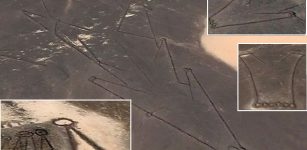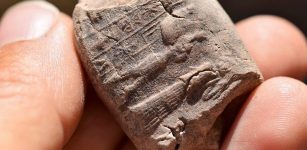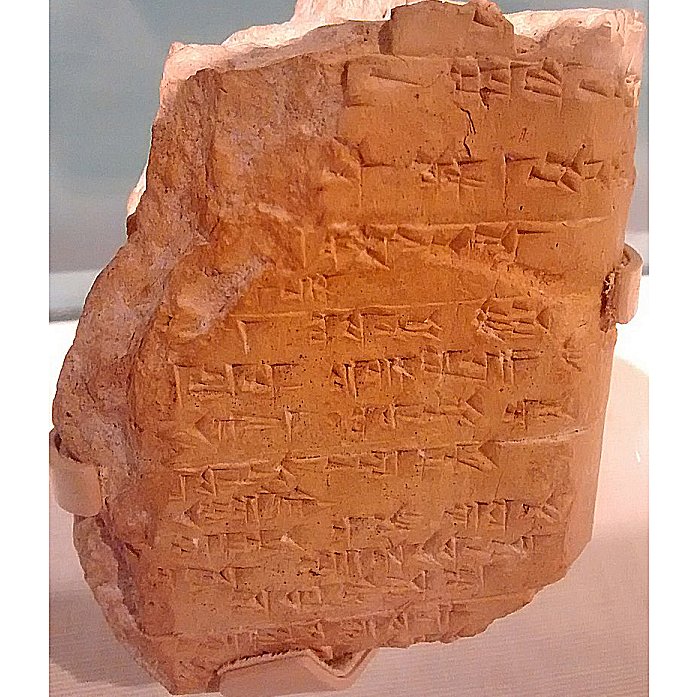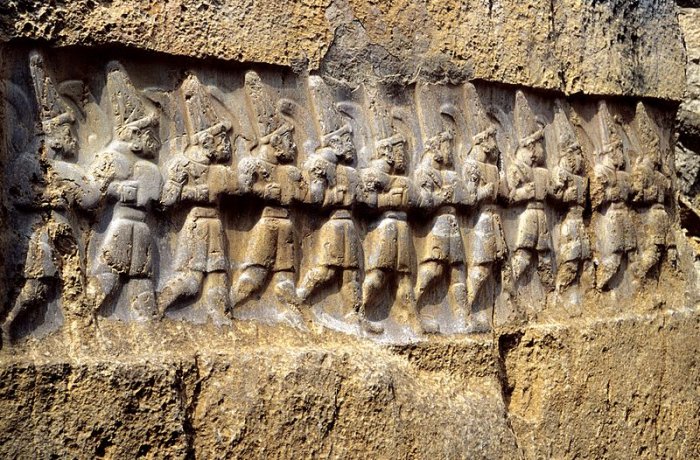The Hittites – Rise And Fall Of An Ancient Powerful Empire
Ellen Lloyd - AncientPages.com - The Hittites were once one of the most powerful ancient civilizations that occupied the ancient region of Anatolia.
This long-gone culture has greatly interested archaeologists and historians, but unraveling the truth about the Hittites has been difficult.
Left: Neo-Hittite storm god "Tarhunzas" in the Aleppo museum. Credit: Verity Cridland, Wikipedia, CC BY 2.0 - Right: Sphinx Gate, Hattusa, Turkey. Credit: Bernard Gagnon, Wikipedia, CC BY-SA 3.0
The Mysterious Language Of The Hittites
Although the civilization was over 4,000 years old, it was first in 1834 that a French scholar discovered ancient ruins that could be linked to the Hittites. Most ancient documents describing this culture that was once a rivaling threat to the ancient Egyptian kingdom were lost in the sand.
Most of the Hittites were illiterate and could not describe their daily lives. However, ancient clay tablets have shed more information on the Hittites. However, one of the problems scientists face when they attempt to decode the script is that many different languages dominated Anatolia during this historical period. The Hittites borrowed words and phrases from other languages, making it difficult for modern scholars to determine this ancient civilization's original roots.
Scientists now say that the mysterious language of the Hittites reveals the history of this ancient civilization is much more complex than previously thought.
Based on what is known, the Hittites were mentioned in the Bible as a mythical kingdom. Still, archaeologists have provided sufficient evidence that this was once a genuine culture that had been buried over time.
Ancient records discovered in Egypt tell of a kingdom called Kheta. Historians connected Kheta with the Biblical Hittites.
 Egyptian pharaoh Ramesses II stormed the Hittite fortress of Dapur. Image credit: Nordisk familjebok - Public Domain
Egyptian pharaoh Ramesses II stormed the Hittite fortress of Dapur. Image credit: Nordisk familjebok - Public Domain
Still, very little was known about this mysterious ancient Anatolian civilization. This changed in 1906 when German archaeologist Hugo Winckler discovered a royal archive with over 10,000 clay tablets inscribed in cuneiform by people using an unknown language. These ancient tablets were the same as those found at Tell el-Amarna in Egypt and on the inscriptions on the monuments found in Turkey.
Czech linguist Derdich Hrozny decoded the script in 1915 and published the results of his study in his book The Language of the Hittites; Its Structure and Its Membership in the Indo-European Linguistic Family. In his book, Hrozny explained that the mysterious language of the Hittites is not Middle Eastern but rather an "Indo-European language.
This discovery opens an intriguing chapter in the history of the Hittites and has led to speculation about where the civilization came from. Could these people have originated from Central Europe? Why were they using an Indo-European language? Some scholars think the Hittites originated from the area beyond the Black Sea.
The Rise And Downfall Of The Hittite Empire
The Hittites entered Anatolia around 2000 B.C., and their capital would eventually be Hattusha in what is today modern Turkey. It took them about 400 years before they developed. The empire's first ruler was Hattusili, which meant "the one from Hattusha."
Once they had organized their society, they started conquering native peoples, such as Hurrians and Hattians. They spread their culture and language throughout the region. Knowledge about their activities has been documented on cuneiform tablets, one of the earliest systems of writing invented by the Sumerians.
As Captivating History writes in the book Hittites: A Captivating Guide to the Ancient Anatolian People Who Established the Hittite Empire in Ancient Mesopotamia, "eventually the Hittites would adopt a cuneiform script from the remnants of Assyrian settlements which stayed after the fall of the larger Assyrian Empire."
From these ancient cuneiform tablets, we have learned about the professions, work, religion, and various aspects of their daily life.
The Hittites were a totalitarian regime with the kings ruling with absolute power. All family activities were monitored and controlled. There was no private ownership because the community owned all property.
A Hittite tablet found at Hattusa is believed to be a legal deposition. Image credit: Mx. Granger - CC0
Like many other great ancient civilizations, the Hittites had laws that regulated various aspects of their vast empire. Written between 1650-1500 BC, the Code of Nesilim was a document that stated the ancient laws of the Hittites. One of its most significant topics is the treatment of slaves. The Code of Nesilim reveals much about the social structure of society. Compared to the Code of Hammurabi, where death was the punishment for most of the offenses described, the punishments stated in the Code of Nesilim were not very severe.
Most of the Hittites were farmers and laborers. Still, there were also powerful landlords, who, according to Captivating History, "supplied the monarchy with much of its power by pledging military service, soldiers, and weapons in exchange for land and occasionally money. Without trust, understanding, and loyalty between the nobility and the king, the kingdom would have fallen apart from a lack of cohesion."
As they expanded their territories, they became a serious threat to our powerful ancient civilizations. Between the 15th and 13th centuries B.C, the Hittite Empire came in conflict with the Egyptian Empire, the Middle Assyrian Empire, and the Mitanni kingdom for control of the Near East. The early Hittite king Mursili[s] I conquered Babylon about 1595 B.C. (some historians suggest it could be as late as 1506 B.C or as early as 1651 B.C)
To prosper, the Hittites had to take control of the trade routes and metal sources. However, the Egyptians were not allowing the Hittite Empire to gain more strategic ground.
This is one of the reasons that led to the Battle of Kadesh, a clash between the forces of the New Kingdom of Egypt under Ramesses II and the Hittite Empire under Muwatalli II that took place in 1274 B.C.
Twelve Hittite gods of the underworld in the nearby Yazilikaya, a sanctuary of Hattusha. Credit: Klaus-Peter Simon, Wikipedia, CC BY 3.0
Historians say it is the best-documented battle in all of ancient history. It was also the largest chariot battle ever fought, involving 5,000 and 6,000 chariots. After having expelled the Hyksos people around 1550 B.C, Egyptian rulers became more aggressive. The Amarna letters reveal Egypt was losing influence in the region.
When pharaoh Ramesses II advanced with his troops on the Hittite-held city of Kadesh, two of the most potent and massive forces engaged each other, and the result was a blow to both states. Because of the significant losses to the Hittites, this battle was won by the Egyptians, but it was a Pyrrhic victory. Nevertheless, the Battle of Kadesh is highly significant because it led to the world's first recorded peace treaty.
An ancient text that survived reads: "Reamasesa-Mai-Amana, the great king, the king of the country of Egypt, shall never attack the country of Hatti to take possession of a part (of this country). And Hattusili, the great king of the country of Hatti, shall never attack the country of Egypt to take possession of a part (of that country). "
The fall of the Hittite Empire came suddenly around 1193 B.C. When Assyrians became the most dominant power in the region, the Hittites lost much of their importance. The Assyrians much of the Hittite Empire, while the Phrygians sacked the rest. This forced the Hittites to split into several independent "Neo-Hittite" city-states, some of which survived until the 8th century B.C before succumbing to the Neo-Assyrian Empire.
The Hittite Empire is long gone, but its legacy is still kept alive. Their ancient ruins found at sites such as Yazilikaya and Hattusha testify to the greatness of this once-powerful civilization. Also, let us not forget that the earliest depiction of the significant double-headed eagle symbol can be found on ancient monuments in central Anatolia in the ancient Kingdom of the Hittites.
Updated on October 23, 2022
Written by Ellen Lloyd – AncientPages.com
Copyright © AncientPages.com All rights reserved. This material may not be published, broadcast, rewritten or redistributed in whole or part without the express written permission of AncientPages.com
Expand for referencesMore From Ancient Pages
-
 Giant Ancient Roman Underground Structure Discovered Near Naples, Italy – Aqua Augusta Investigated
Archaeology | Feb 6, 2023
Giant Ancient Roman Underground Structure Discovered Near Naples, Italy – Aqua Augusta Investigated
Archaeology | Feb 6, 2023 -
 Porobonus – Mysterious Unknown Pagan God
Artifacts | Aug 28, 2015
Porobonus – Mysterious Unknown Pagan God
Artifacts | Aug 28, 2015 -
 Skeleton Of Irish Giant Charles Byrne Will Not Be Displayed In The Hunterian Museum In London
Historical Figures | Jan 13, 2023
Skeleton Of Irish Giant Charles Byrne Will Not Be Displayed In The Hunterian Museum In London
Historical Figures | Jan 13, 2023 -
 Huge Untouched Vassal King Tomb From The Ming Dynasty Discovered In Xinfu District, China
Archaeology | Mar 22, 2024
Huge Untouched Vassal King Tomb From The Ming Dynasty Discovered In Xinfu District, China
Archaeology | Mar 22, 2024 -
 Broken Pebbles In Arene Candide Cave Shed New Light On Ancient Burial Practices
Archaeology | Mar 7, 2017
Broken Pebbles In Arene Candide Cave Shed New Light On Ancient Burial Practices
Archaeology | Mar 7, 2017 -
 Armenia: Old Land Where Myths, Legends And Long History Meet
Civilizations | Apr 20, 2016
Armenia: Old Land Where Myths, Legends And Long History Meet
Civilizations | Apr 20, 2016 -
 2,000-Year-Old Roman House Discovered In Malta
Archaeology | Jul 27, 2023
2,000-Year-Old Roman House Discovered In Malta
Archaeology | Jul 27, 2023 -
 Mythical Shield-Maidens Did Exist – Evidence Of Female Viking Warriors Discovered
Archaeology | Sep 9, 2017
Mythical Shield-Maidens Did Exist – Evidence Of Female Viking Warriors Discovered
Archaeology | Sep 9, 2017 -
 500 Million Year-Old Fossils Solve A Centuries-Old Evolutionary Riddle
Archaeology | Nov 7, 2022
500 Million Year-Old Fossils Solve A Centuries-Old Evolutionary Riddle
Archaeology | Nov 7, 2022 -
 Ancient Wall Of Lolei Temple Built In 893 BC Unearthed In Siem Reap, Cambodia
Archaeology | Apr 20, 2020
Ancient Wall Of Lolei Temple Built In 893 BC Unearthed In Siem Reap, Cambodia
Archaeology | Apr 20, 2020 -
 Thousands Unknown Ancient Structures Seen From Space: Puzzling Aerial Archaeology In The Middle East
News | Feb 15, 2014
Thousands Unknown Ancient Structures Seen From Space: Puzzling Aerial Archaeology In The Middle East
News | Feb 15, 2014 -
 New DNA Study Links Early Europeans’ Cultural And Genetic Development Over Several Thousand Years
Archaeology | Aug 9, 2023
New DNA Study Links Early Europeans’ Cultural And Genetic Development Over Several Thousand Years
Archaeology | Aug 9, 2023 -
 Roman Ship Cargo And Galley Equipment Discovered Underwater In The Caesarea Harbor
Archaeology | Sep 12, 2023
Roman Ship Cargo And Galley Equipment Discovered Underwater In The Caesarea Harbor
Archaeology | Sep 12, 2023 -
 Stone Water Well Dated To Sassanid Era (224-651 CE) Unearthed In Isfahan Hills, Iran
Archaeology | Jun 26, 2020
Stone Water Well Dated To Sassanid Era (224-651 CE) Unearthed In Isfahan Hills, Iran
Archaeology | Jun 26, 2020 -
 Rare 1,600-Year-Old Wooden Pagan Idol Discovered In Ireland
Archaeology | Aug 16, 2021
Rare 1,600-Year-Old Wooden Pagan Idol Discovered In Ireland
Archaeology | Aug 16, 2021 -
 Mystery Of The Roman Tile Kiln At Brandiers Farm Solved!
Archaeology | Aug 18, 2023
Mystery Of The Roman Tile Kiln At Brandiers Farm Solved!
Archaeology | Aug 18, 2023 -
 Mysterious Ancient Village In A Prehistoric Anomalous Zone – Unexplained Sightings And Sounds – Part 1
Featured Stories | Jul 27, 2020
Mysterious Ancient Village In A Prehistoric Anomalous Zone – Unexplained Sightings And Sounds – Part 1
Featured Stories | Jul 27, 2020 -
 Children Of Lir And Aoife’s Curse – Celtic Legend That Inspired The Swan Lake Ballet
Featured Stories | Feb 8, 2024
Children Of Lir And Aoife’s Curse – Celtic Legend That Inspired The Swan Lake Ballet
Featured Stories | Feb 8, 2024 -
 Old Babylonian Residential Building In Ur Dated To 1835 BC – Investigated
Archaeology | Jul 24, 2019
Old Babylonian Residential Building In Ur Dated To 1835 BC – Investigated
Archaeology | Jul 24, 2019 -
 Sir William Wallace: Brave Scottish Knight And Legendary Hero
Featured Stories | Feb 27, 2016
Sir William Wallace: Brave Scottish Knight And Legendary Hero
Featured Stories | Feb 27, 2016



